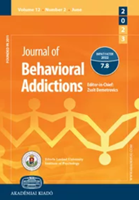Problematic use of the internet among adolescents: A four-wave longitudinal study of trajectories, predictors and outcomes
Problematic use of the internet among adolescents: A four-wave longitudinal study of trajectories, predictors and outcomes
Author(s): Xiaomin Geng, Jialin Zhang, Yang LIU, Linxuan Xu, Yue Han, Marc N. Potenza, Jintao ZhangSubject(s): Behaviorism, Substance abuse and addiction, Health and medicine and law, Policy, planning, forecast and speculation
Published by: Akadémiai Kiadó
Keywords: problematic use of the internet; internet addiction; addictive behaviors; family; maladjustment; adolescents;
Summary/Abstract: Background and aims: Problematic use of the internet (PUI) among adolescents has become one of the public problems around the world. Understanding the developmental trajectory of PUI may be beneficial to develop prevention and intervention. The current study aimed to identify the developmental trajectories of PUI among adolescents, considering individual differences over time. And also explored how familial factors contributed to the identified trajectories, and the relationship between PUI changes over time and social, mental health, and academic functioning. Methods: A total of 1,149 adolescents (Mage 5 15.82, SD 5 0.61; 55.27% girls at Wave 1) participated in assessments at four time points, using 6-month assessment intervals. Results: Based on a latent class growth model, three trajectories of PUI were identified: Low Decreasing, Moderate Increasing, and High Increasing groups. Multivariate logistic regression analyses suggested that inter-parental conflicts and childhood maltreatment served as negative familial predictors for the risk trajectories of PUI (i.e., Moderate Increasing and High Increasing groups). Additionally, adolescents in these two groups displayed more estranged interpersonal relationships, more mental health difficulties, and poorer academic functioning. Discussion and conclusions: It is important to consider individual differences in understanding the developmental patterns of PUI among adolescents. Identifying family predictors and the behavioral outcome associated with groups with different developmental trajectories of PUI, which may help to understand better risk factors related to specific developmental patterns of PUI and its adverse correlates. The findings highlight a need to develop more specific effective intervention programs for individuals displaying different problematic developmental trajectories with PUI.
Journal: Journal of Behavioral Addictions
- Issue Year: 12/2023
- Issue No: 2
- Page Range: 435-447
- Page Count: 13
- Language: English

